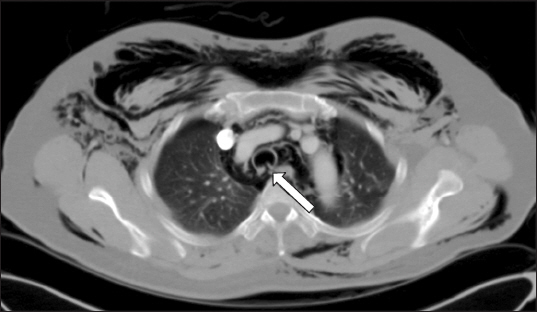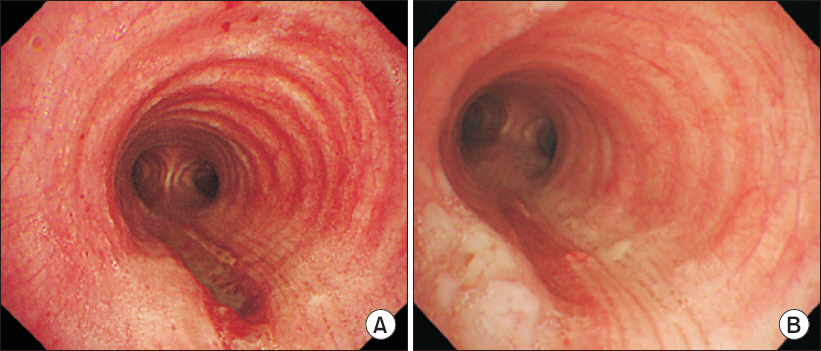Anesth Pain Med.
2018 Jan;13(1):102-106. 10.17085/apm.2018.13.1.102.
Delayed diagnosis of postintubation tracheal laceration in a patient who underwent septorhinoplasty including osteotomy: A case report
- Affiliations
-
- 1Department of Anesthesiology and Pain Medicine, National Police Hospital, Seoul, Korea.
- 2Department of Otorhinolaryngology, Pusan National University Yangsan Hospital, Yangsan, Korea.
- 3Department of Anesthesia and Pain Medicine, Pusan National University Yangsan Hospital, Yangsan, Korea. yoonji07@gmail.com
- 4Department of Anesthesiology and Pain Medicine, Korea University Guro Hospital, Seoul, Korea.
- KMID: 2436064
- DOI: http://doi.org/10.17085/apm.2018.13.1.102
Abstract
- Iatrogenic postintubation tracheal injury is a rare but potentially fatal complication associated with anesthesia. However, as signs of tracheal injury including subcutaneous emphysema, pneumomediastinum, pneumothorax, and respiratory distress may also be related to surgical technique, diagnosis may be confused and treatment of tracheal injury can be delayed. We report a case of postintubation tracheal laceration, whose diagnosis was delayed because of symptoms were confused with subcutaneous emphysema after septorhinoplasty including osteotomy. As symptoms deteriorated in spite of conventional management, patient underwent evaluation to determine other causes and eventually postintubation tracheal injury was detected. Therefore, even if there is no problem during tracheal intubation, it is necessary to consider postintubation tracheal injury in patients with subcutaneous emphysema that worsens despite appropriate treatment after septorhinoplasty including osteotomy.
MeSH Terms
Figure
Reference
-
1. Massard G, Rougé C, Dabbagh A, Kessler R, Hentz JG, Roeslin N, et al. Tracheobronchial lacerations after intubation and tracheostomy. Ann Thorac Surg. 1996; 61:1483–7. DOI: 10.1016/0003-4975(96)00083-5.2. Cardillo G, Carbone L, Carleo F, Batzella S, Jacono RD, Lucantoni G, et al. Tracheal lacerations after endotracheal intubation: a proposed morphological classification to guide non-surgical treatment. Eur J Cardiothorac Surg. 2010; 37:581–7. DOI: 10.1016/j.ejcts.2009.07.034. PMID: 19748275.3. Hussein E, Pathak V, Shepherd RW, Shojaee S. Bronchoscopic management of iatrogenic tracheal laceration using polyurethane-covered nitinol tracheal stents. J Trauma Acute Care Surg. 2016; 81:979–83. DOI: 10.1097/TA.0000000000001233. PMID: 27602904.4. Durukan P, Salt O, Ozkan S, Durukan B, Kavalci C. Cervicofacial emphysema and pneumomediastinum after a high-speed air drill endodontic treatment procedure. Am J Emerg Med. 2012; 30:2095. DOI: 10.1016/j.ajem.2012.01.006. PMID: 22306391.5. Kim ES, Kang JW, Kim CH, Hong JM. Cervical subcutaneous emphysema and pneumomediastinum after septorhinoplasty. J Craniofac Surg. 2014; 25:533–4. DOI: 10.1097/SCS.0000000000000693. PMID: 24577299.6. Celebioğlu S, Keser A, Ortak T. An unusual complication of rhinoplasty: subcutaneous emphysema. Br J Plast Surg. 1998; 51:266–7. DOI: 10.1016/S0007-1226(98)80027-1.7. Carbognani P, Bobbio A, Cattelani L, Internullo E, Caporale D, Rusca M. Management of postintubation membranous tracheal rupture. Ann Thorac Surg. 2004; 77:406–9. DOI: 10.1016/S0003-4975(03)01344-4.8. Jougon J, Ballester M, Choukroun E, Dubrez J, Reboul G, Velly JF. Conservative treatment for postintubation tracheobronchial rupture. Ann Thorac Surg. 2000; 69:216–20. DOI: 10.1016/S0003-4975(99)01129-7.9. Denlinger CE, Veeramachaneni N, Krupnick AS, Patterson GA, Kreisel D. Nonoperative management of large tracheal injuries. J Thorac Cardiovasc Surg. 2008; 136:782–3. DOI: 10.1016/j.jtcvs.2007.12.040. PMID: 18805287.10. Conti M, Pougeoise M, Wurtz A, Porte H, Fourrier F, Ramon P, et al. Management of postintubation tracheobronchial ruptures. Chest. 2006; 130:412–8. DOI: 10.1378/chest.130.2.412. PMID: 16899839.11. Gómez-Caro A, Ausín P, Moradiellos FJ, Díaz-Hellín V, Larrú E, Pérez JA, et al. Role of conservative medical management of tracheobronchial injuries. J Trauma. 2006; 61:1426–34. DOI: 10.1097/01.ta.0000196801.52594.b5. PMID: 17159686.12. Towe C, Solomon B, Donington JS, Pass HI. Treatment of recalcitrant subcutaneous emphysema using negative pressure wound therapy dressings. BMJ Case Rep 2014. 2014; bcr2014205577.13. Kim PJ, Attinger CE, Olawoye O, Crist BD, Gabriel A, Galiano RD, et al. Negative pressure wound therapy with instillation: review of evidence and recommendations. Wounds. 2015; 27:S2–19.
- Full Text Links
- Actions
-
Cited
- CITED
-
- Close
- Share
- Similar articles
-
- A Case of Postintubation Tracheal Stenosis Treated by Endoscopic Nd-YAG Laser and Balloon Catheter
- Tracheal laceration found after endotracheal general anesthesia : A case report
- Tracheal Laceration Due to Thyroid Cartilage Fracture: One Case Report
- Airway Obstruction by Swelling of Inner Wall of Armored Tube and Tracheal Laceration during Endoscopic Thyroidectomy: A case report
- Airway obstruction due to post intubation circumferential tracheal web formation: A case report



